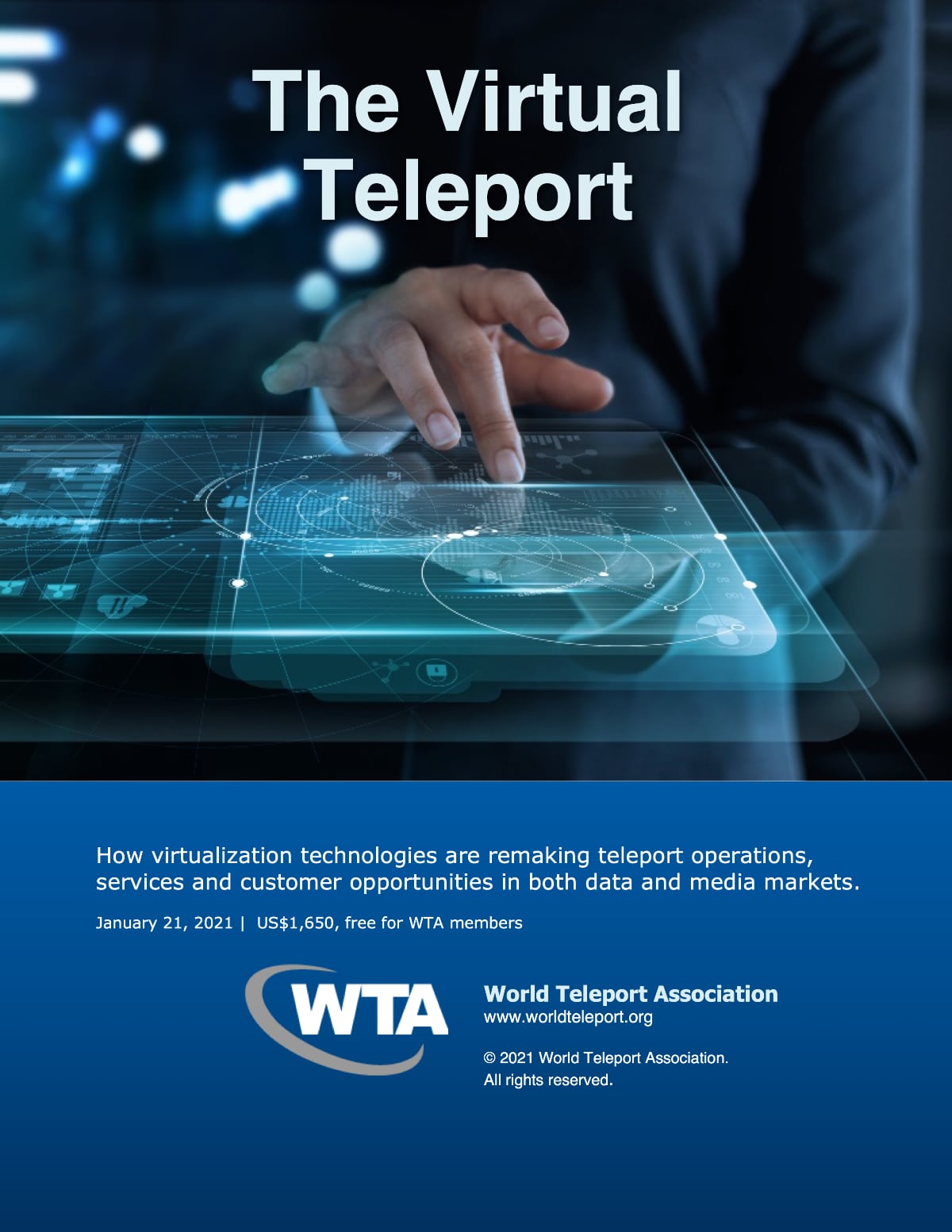In the Land of the Virtual
by Robert Bell
New York City, NY, April 2, 2021--The pandemic has made those of us lucky enough to still have jobs wince at the word “virtual.” We take part in virtual meetings and virtual cocktail hours. We attend virtual conferences, receive virtual medical care and see virtual versions of our adult children and young grandchildren. It is virtually impossible to escape from our screened-in lives. On the other hand, I have to point out that we are very short on gratitude when it comes to appreciating all that virtualization has allowed us to preserve.
In the satellite communications business, virtualization is about much more than faces on screens, as I discovered in editing a new WTA report, The Virtual Teleport, sponsored by a leader in the technology, Kratos.
What is Virtualization?
 Virtualization describes the transition of computer applications from dedicated hardware to software that runs on commodity servers. The most common examples are email and internet applications, which used to run on dedicated hardware and use only a fraction of its processing and storage capacity. In a virtualized environment, multiple applications can share the same physical machine, increasing efficiency and conserving resources.
Virtualization describes the transition of computer applications from dedicated hardware to software that runs on commodity servers. The most common examples are email and internet applications, which used to run on dedicated hardware and use only a fraction of its processing and storage capacity. In a virtualized environment, multiple applications can share the same physical machine, increasing efficiency and conserving resources.
It’s not a new idea. The first computer supporting virtualization was a mainframe developed by IBM for scientific use in 1968. Upgraded and commercialized in 1970, it became VM/370 OS, which ran one of the most popular mainframes in IBM history, the System/370. But it was the evolution of the internet that brought virtualization into its own, because website hosting companies needed a flexible, reliable way to divide up their server capacity among thousands or millions of users.
Playing Catch Up
Terrestrial IT and telecom have been in the virtualization game for decades – the latest iteration being cloud computing. But it has only recently begun to catch on with teleport and satellite operators. There are many reasons for it from sunk investment and proprietary standards to a long industry tradition of operating closed-loop systems.
But this reality is changing as satellite and teleport operators learn the virtues of virtualization. The degree of virtualization varies among operators, but there is general agreement that the trend will pick up steam in the coming years. There is simply too much to gain and too much to lose by maintaining the status quo, especially as the industry vies for new customers in an increasingly competitive environment and seeks to integrate more closely with the broader terrestrial communications grid.
From a report based on interviews with executives in teleport, satellite and technology companies, I offer a few key insights.
The Applications
One of the most basic kinds of virtualization in teleports is automation in the network operations center or NOC, the nerve center of a facility or multiple facilities. The ability to monitor performance across widely dispersed assets enhances network reliability by allowing operators to spot trends that could presage a costly service outage and address the issue preemptively.
Once key elements of the network and traffic riding on it have been virtualized, it creates opportunities for a higher level of operation. Called service orchestration, it aligns the applications, data and infrastructure with business requirements. It defines policies and service levels to guide operations and then automates workflows, provisioning, and change management.
One area ripe for virtualization is radio frequency (RF) signal processing and distribution. The key to virtualizing these functions is the conversion of analog RF signals to digital (typically IP) signals as close to the antenna as possible. Once those signals are digitized, subsequent functions can be orchestrated from miles away using software. Whole new architectures are being built based on the ability to digitize RF signals.
Many if not most operators are integrating cloud-based computing into their processes. It gives satellite and ground segment operators the option to buy capacity on a pay-for-use basis, which allows processing to be spun up when needed and spun down just as easily, turning fixed capex for computing into a variable operating expense.
Growth Opportunities
Virtualization is providing growth opportunities across the industry. It facilitates expansion into new geographic markets by reducing the infrastructure costs involved. Integrating a new antenna into a network – once a costly and time-consuming endeavor, when most functions were hardware-based – now can be done in a day or two.
A related advantage is that, through virtualization, ground network operators are able to scale up quickly as dictated by demand. When a network is built out with hardware, the entire infrastructure investment must be made up front, even if initial demand requires only 25 percent of capacity. With virtualization, the processing elements of the network can be built out in software as demand dictates.
Moreover, virtualization enables better service in key markets such as maritime, where satellite services have long dominated. In effect, customers in these markets have come to expect OSS/BSS integration that allows them monitor network performance.
Virtualization enables the integration of satellite with the operational support systems and business support systems of terrestrial networks, from wired telecom to mobile network operators, creating opportunities that previously were unavailable to satellite operators. Increasingly, teleport operators must provide more than satcom, because customers expect a complete solution with integrated, multi-layered communication technology.
At the extreme end of virtualization strategies are the companies offering ground segment as a service or GSaaS. Of course, ground segment cannot be entirely virtual. Somewhere, there are antennas, RF chains, HPAs, modems and the rest of the teleport infrastructure. The difference is in the business model. GSAAS companies consciously limit their hardware investments by using other companies’ resources whenever possible. There may be operating agreements with third-party teleport operators to dedicate an antenna to their services, or collocation deals that put the GSAAS operator’s antenna at a third-party teleport. Where traditional teleport operators have unused capacity, GSAAS operators become customers.
The GSAAS companies’ special sauce is the ability to manage this far-flung network of earth stations to meet their customers’ needs. That is where clever software and virtualization play a critical role eliminating the standing IT army that traditionally would be required to monitor, control, maintain and operate a large ground network.
Whether or not satellite and terrestrial telecommunications infrastructure ultimately merge into one, as many experts envision or hope, the pull of virtualization will only grow stronger in the years ahead. Companies that balk, or even hesitate, risk being left behind.
-------------------------------------
.jpg) Robert Bell is Executive Director of the World Teleport Association, which represents the world’s most innovative teleport operators, carriers and technology providers in 46 nations. He can be reached at rbell@worldteleport.org
Robert Bell is Executive Director of the World Teleport Association, which represents the world’s most innovative teleport operators, carriers and technology providers in 46 nations. He can be reached at rbell@worldteleport.org
"The Virtual Teleport" report is available for free to members and for sale to non-members at https://www.worldteleport.org/store/viewproduct.aspx?id=17787849






